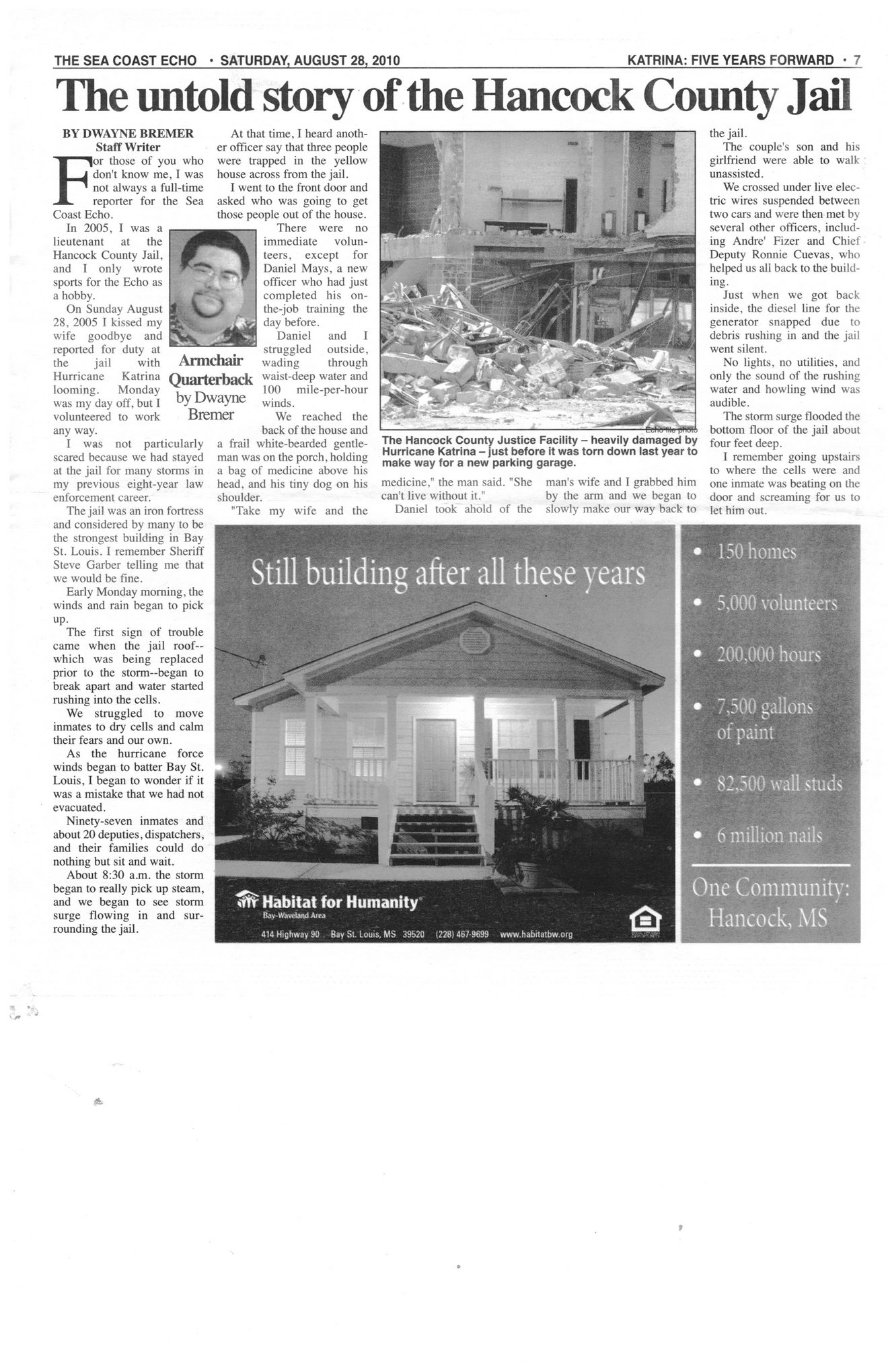This text was obtained via automated optical character recognition.
It has not been edited and may therefore contain several errors.
THE SEA COAST ECHO • SATURDAY, AUGUST 28, 2010 KATRINA: FIVE YEARS FORWARD • 7 The untold story of the Hancock County Jail BY DWAYNE BREMER Staff Writer For those of you who don't know me, I was not always a full-time reporter for the Sea Coast Echo. In 2005, I was a lieutenant at the Hancock County Jail, and I only wrote sports for the Echo as a hobby. On Sunday August 28, 2005 I kissed my wife goodbye and reported for duty at the jail with Hurricane Katrina looming. Monday was my day off, but I volunteered to work any way. I was not particularly scared because we had stayed at the jail for many storms in my previous eight-year law enforcement career. The jail was an iron fortress and considered by many to be the strongest building in Bay St. Louis. I remember Sheriff Steve Garber telling me that we would be fine. Early Monday morning, the winds and rain began to pick up. The first sign of trouble came when the jail roof— which was being replaced prior to the storm—began to break apart and water started rushing into the cells. We struggled to move inmates to dry cells and calm their fears and our own. As the hurricane force winds began to batter Bay St. Louis, I began to wonder if it was a mistake that we had not evacuated. Ninety-seven inmates and about 20 deputies, dispatchers, and their families could do nothing but sit and wait. About 8:30 a.m. the storm began to really pick up steam, and we began to see storm surge flowing in and surrounding the jail. Armchair Quarterback by Dwayne Bremer At that time, I heard another officer say that three people were trapped in the yellow house across from the jail. I went to the front door and asked who was going to get those people out of the house. There were no immediate volunteers, except for Daniel Mays, a new officer who had just completed his on-the-job training the day before. Daniel and I struggled outside, wading through waist-deep water and 100 mile-per-hour winds. We reached the back of the house and a frail white-bearded gentleman was on the porch, holding a bag of medicine above his head, and his tiny dog on his shoulder. "Take my wife and the The Hancock County Justice Facility - heavily damaged by Hurricane Katrina - just before it was torn down last year to make way for a new parking garage. medicine," the man said. "She man's wife and I grabbed him can't live without it." by the arm and we began to Daniel took ahold of the slowly make our way back to the jail. The couple's son and his girlfriend were able to walk unassisted. We crossed under live electric wires suspended between two cars and were then met by several other officers, including Andre' Fizer and Chief Deputy Ronnie Cuevas, who helped us all back to the building. Just when we got back inside, the diesel line for the generator snapped due to debris rushing in and the jail went silent. No lights, no utilities, and only the sound of the rushing water and howling wind was audible. The storm surge flooded the bottom floor of the jail about four feet deep. I remember going upstairs to where the cells were and one inmate was beating on the door and screaming for us to let him out. • 150 homes • 5,000 volunteers • 200,000 hours • 7,500 gallons of paint • 82,500 wall studs • 6 million nails One Community: Hancock, MS »

Pearlington Katrina Document (102)